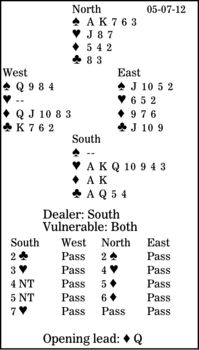Bridge column, May 7: Declarer's fork has two tines

The number of tines in a fork has changed over history, but four is the rule today.
A bridge declarer should work for as many tines -- possible winning lines of play -- as possible. Even if one stands out, check for others to see if you might be able to combine them.
In this example, what is the correct play in the pushy seven-heart contract after West leads the diamond queen?
At first glance, the club finesse needs to be working. But there is a second chance: The spades might split 4-4. Yes, that is less likely than a finesse (32.72 percent versus 50 percent), but it is possible to combine both chances.
South wins with his diamond ace, plays a low trump to dummy's seven, ruffs a spade high in his hand, returns to dummy with another low heart, ruffs another spade high, and goes back to dummy with a heart to the jack, which draws East's remaining trump.
Now declarer cashes the ace and king of spades, discarding clubs from his hand. When they do divide evenly, the club queen disappears on the spade seven and South claims. But if the spades had proved to be unfavorable, the club finesse would have still been available. The chances of success have risen to a reasonable 66.4 percent.
** ** **
COPYRIGHT: 2012, UNITED FEATURE SYNDICATE
DISTRIBUTED BY UNIVERSAL UCLICK FOR UFS

